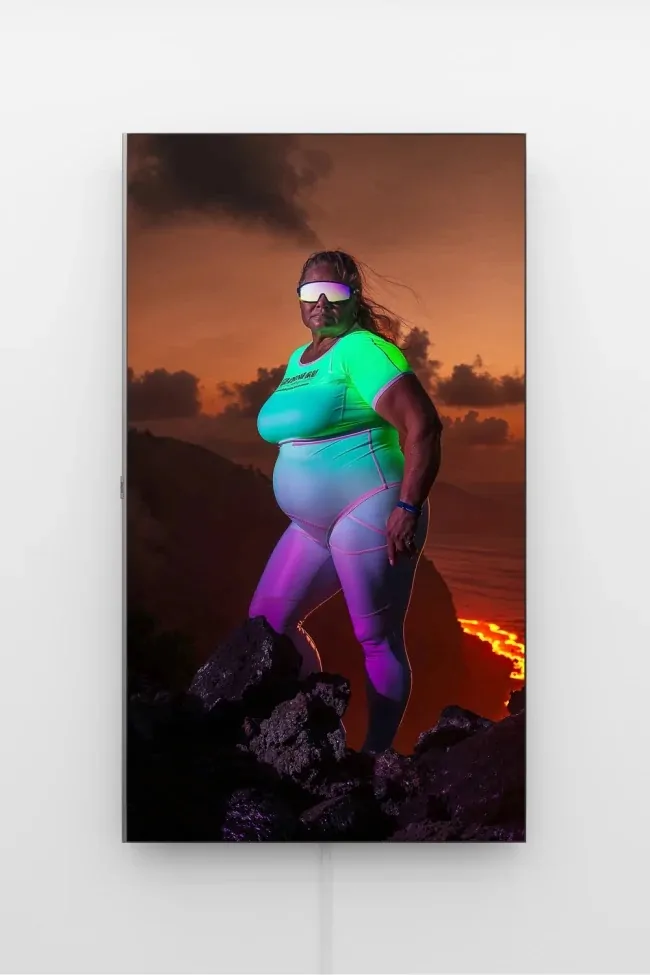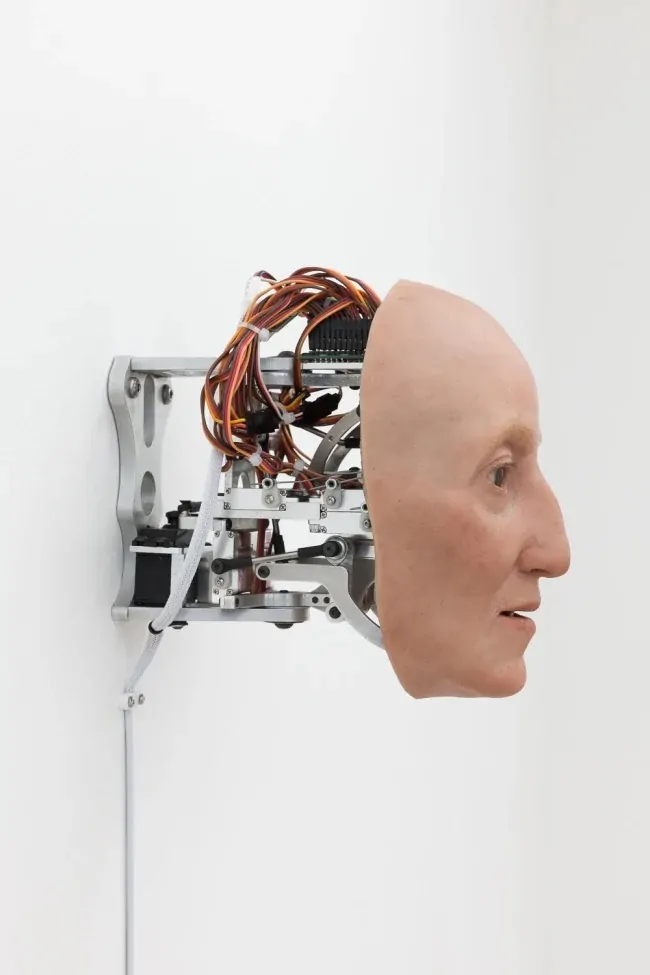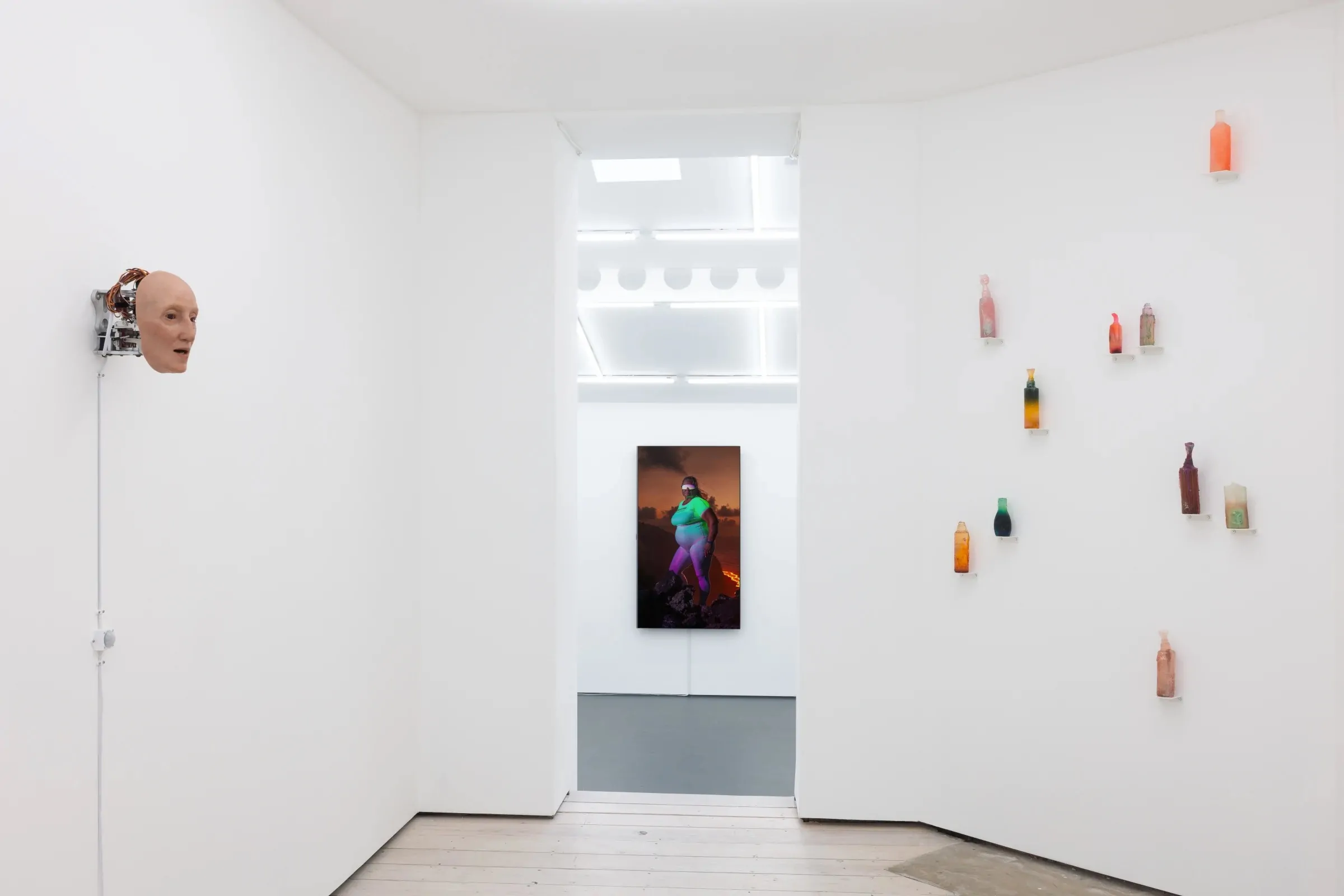BEST SELF Curated by Polly Morgan
23rd May, 2025 – 28th June, 2025
Brooke Benington
76 Cleveland Street
London W1T 6NB
‘Choose your self-presentations carefully, for what starts out as a mask may become your face.’ Erving Goffman in The Presentation of Self in Everyday Life
Featuring Juno Calypso, Mat Collishaw, Polly Morgan, Christopher Page, Boo Saville, Julia Thompson & Bengt Tibert.
At a moment when personal identity is continually presented, polished and performed, a new exhibition poses a quietly radical question: What might happen if all our selves were to meet?
Would the confident figure who commands attention at a dinner party recognise herself in the unguarded version who cries in solitude? Could the one who posts images online admire the one who faces the world without make-up—or would she flinch? There may be flashes of solidarity, fleeting gestures of kinship, before the more familiar rituals of judgement and separation take hold.

Volcano, 2024
Created using Midjourney, Magnific and Runwayml
Music made with Suno.ai
Duration 0:27
Format 9:16
Unique
Courtesy of the artist and Brooke Benington
Fiction offers little comfort. In Oscar Wilde’s The Picture of Dorian Gray, the youthful protagonist stabs the portrait of his ageing self, and perishes alongside it. In The Substance, Lucy McKenzie presents a ‘best self’ who is repelled by her binge-eating counterpart and locks her away. These cautionary tales speak to an age-old suspicion: that unity of self is more myth than possibility.
In contemporary life, the splitting of the self is no longer symbolic. A thriving industry of anti-ageing treatments and ‘longevity’ programmes is promoted with a fervour once reserved for religion. Funded by billionaires and marketed to the masses, such pursuits promise eternal youth in a world still shaped by vanity and loss. Their glossy language—‘protocols’, ‘wellness’, ‘optimisation’—belies a familiar message: resist decline at all costs, and pay handsomely for the privilege.
Julia Thompson’s sculptural works echo this promise and its discontents. Her gleaming vessels, reminiscent of luxury beauty products, are formed from substances drawn from traditional rituals of femininity: make-up, sugar, perfume, soap, vodka. They emerge like confectionary figurines—flawless at first glance, but soon buckling under the weight of their own contradictions. Over time, they grow warped, cracked and slumped. The pretence of perfection cannot endure.
Such expectations weigh most heavily on women. The imperative to appear unchanged, unmarked by time, is rarely questioned. Boo Saville’s Emerge (Quarantine) shows a woman peeling off a cleansing mask—its clinical associations hinting at both care and compulsion. Is this ritual one of renewal, or of erasure? Centuries earlier, Queen Elizabeth I used lead-based foundation to maintain an unblemished image, even as it damaged her skin. One layer covered another, and the truth grew more distant.

The Mask of Youth, 2018
Acrylic, aluminium, brass, electrical circuitry, glass, paint, PIR motion sensor, silicone, squirrel hair, steel, wood
132 x 118 x 25 cm
52 x 46 1/2 x 9 7/8 in.
Unique
Courtesy of the artist and Brooke Benington
Would she have recognised herself in Mask of Youth, Mat Collishaw’s robotic reimagining of her unvarnished appearance? Based on forensic research, the silicone likeness reveals not the triumphant sovereign of the Armada Portrait, but a woman marked by pox and pressure. This, presumably, is not the face she would have wanted to outlast her.
In contrast, Bengt Tibbert’s vividly stylised female figures are exempt from such concerns. Constructed through digital means, they appear unburdened by time or biology. Dressed in neon sportswear and set against spectacular landscapes, they strike exaggerated poses—either survivors of catastrophe or echoes of influencer culture, performing vitality while the world smoulders around them. Their resilience is dazzling, if ultimately hollow.
Polly Morgan offers a quieter, more poignant reflection in Here Lies Our World. Five small cement tablets, cast from the inside of an iPhone box, resemble gravestones. Nestled in one—where the camera lens once lay—is a brightly coloured snake, repeated in subtle variations across the group. Like species adapting to a changing climate—or selfies endlessly refined in pursuit of digital approval—they inch forward, seeking relevance, only to be replaced by something marginally ‘better’.

Here Lies our World, 2025
Cement composite, polyurethane, acrylic paint, oil paint, lacquer
24 x 23 x 5 cm
9 1/2 x 9 x 2 in.
Unique
Courtesy of the artist and Brooke Benington
With the arrival of the front-facing camera, the smartphone joined the mirror as an instrument of self-surveillance. Christopher Page’s That Which Is Missing plays with this idea. A painted analogue mirror, so precisely rendered it seems real, reflects nothing. Draw closer, and the illusion breaks: we are not there. In place of reflection, absence.
A similar ambiguity runs through Juno Calypso’s Silent Retreat, in which a woman floats in a swimming pool surrounded by mirrors. She wears a gleaming facial mask, its surface blank and unnerving. Though reflected multiple times, she remains unreadable—more doll than person. The scene evokes the curated opacity of social media, where presence is constant but meaning elusive.
Today’s digital tools allow anyone to retouch, reshape, and reinvent their appearance. But in crafting the ideal face—the one that survives beyond time and tide—we may be leaving the self behind. From monarch to influencer, the mirror remains the same. The question, as ever, is: what do we hope to see?
BEST SELF Curated by Polly Morgan opens on the 23rd of May, 2025 until the 28th of June, 2025 at Brooke Benington
©2025 Brooke Benington





